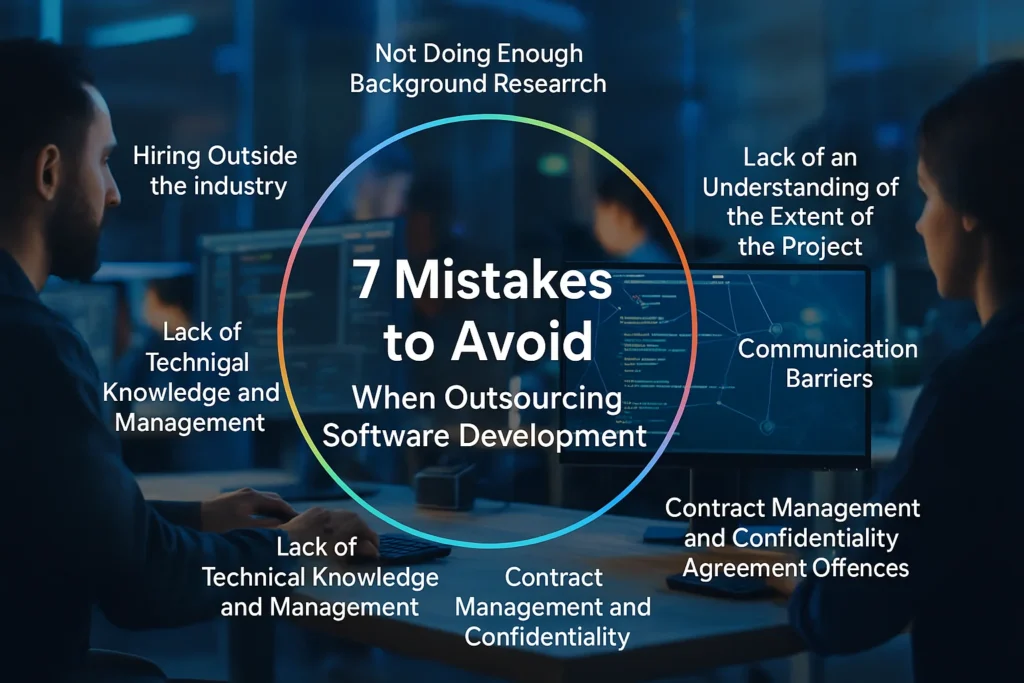Outsourcing is a great way for a business to reduce expenditure, identify fresh talent, and complete its software development faster. But that’s not the end of the story since this system is not without its disadvantages. Having more dreams than resources compels many firms to make blunders while implementing change.
It is also causing schedules to stretch out, quality to drop, and partnerships to fail. As a first-time business owner or a new business owner who is operationally expanding, it is just as valuable to know what not to implement.
Outsourcing strategies and techniques for avoiding fundamental errors that can lead to project failure and disappointment. In the following blog post, we outline 7 common pitfalls companies encounter throughout the software outsourcing process.
Top 7 Mistakes to Avoid When Outsourcing Software Development

Here is the list of mistakes you should avoid:
1. Not Doing Enough Background Research
Mistake:
Outsourcing has become a widely adopted practice, with diverse opinions surrounding it. However, choosing an outsourcing platform or company without proper research can result in subpar deliverables and unreliable partnerships.
To cut expenses, some companies ignore important factors such as the company portfolio, its reviews, success stories, and openness—especially when it comes to software development outsourcing.
Solution:
In essence, when entering into a contract with a particular vendor, ensure you conduct a thorough background check on the vendor. Seek out firms that are engaging in social media, have real client referrals, have case studies, and have an easily understood price structure. It means that the selected outsourcing partner should have an open line of communication and past successful projects.
While it may seem obvious, do not simply take their word for it—request references, speak with previous clients, and even have them complete a brief trial run on a project. This lowers the probabilities of hiring fraudsters and increases the possibilities of assembling a competent team that delivers results.
2. Lack of an Understanding of the Extent of the Project
Mistake:
When outsourcing, one is likely to find oneself in situations where all the stakeholders have different expectations regarding the scope of the project in question. It means if you fail to outline the goals and time frames of the project clearly, the outsourcing team will not know them either.
Solution:
To outsource, one must first develop the Software Requirements Specification (SRS) documentation. This document should contain goals and features of the project, its timeframe, and the audience, as well as field-specific aspects and technologies needed for the project.
However, always ensure that a scope of work is practical in terms of your business aims and financial means. Subdivide work into phases such as pre-production, production, and post-production, among others, and map the work as a Gantt chart and flow diagrams.
Establish bodies and timelines, and respond to reviewers’/clients’ comments with required urgency at the initial stage. A clear and detailed scope helps in proper planning and management and makes it easier for a development team to achieve the set goals.
3. Communication Barriers
Mistake:
Dealing with language barriers and cultural differences, as well as time zones, can lead to misunderstandings and project inefficiencies, even if the outsourced developers are highly qualified.
Solution:
Select third-party contractors who are fluent in the desired language of communication and who work at the same time as your business. Find nearshore or culturally proximal partners to work with to reduce the difficulty of collaboration. Communicate daily, if possible, via video calls, and employ project management tools such as Slack, Trello, or Jira.
Moreover, it is vital to define communication protocols. Aim at scheduling regular status updates and avoid leaving her any room for confusion. Communication enables people to develop trust and familiarity and/or minimize mistakes or miscommunications that can slow down a project.
4. Contract Management and Confidentiality Agreement Offences
Mistake:
Neglecting items like contracts and NDAs means that issues could arise in terms of a lawsuit, leaked information, or products delivered without a way to recover them legally.
Solution:
Ensure you prepare a comprehensive legal document that spells out the project scope, date, and time frame for delivery, method of payment, ownership of project deliverables, and provisions for handling an emergency eventuality.
Moreover, you should sign an NDA to ensure that you protect your business information. It is recommended that an attorney review both documents.
Especially when securing work for information-sensitive projects, it is important to have a strong contract and NDA in place to lessen all risks and clear up misunderstandings when unforeseen problems arise in the future.
5. Lack of frequent and proper tracking and monitoring of the projects
Mistake:
Not checking the status frequently may lead to the failure to submit projects on time. Poor work may not be detected early enough, and problems are left unreported.
Solution:
Ensure that you are planning and initiating a project with a substantial tracking mechanism in place. Asana, ClickUp, and Basecamp are some examples of tools that help with the visibility of timelines, milestones, and assignments.
Appoint someone to be in charge of making changes, observing its quality, and coordinating with others (either from within the company or outside it). It is vital to define clear criteria for accepting each phase of the project, as well as periodically reviewing the codebase.
Another advantage is that constant monitoring of the project allows for the identification of some problems that may occur. So that intervention can be done to prevent them from delaying the project.
6. Lack of technical knowledge and management
Mistake:
Working with a team that is out of your sight is risky for the same reason because you seldom can evaluate their aptitude; moreover, you may end up making bad decisions for your business and get a low-quality result in return.
Solution:
If your team does not have sufficient technical expertise, hire a technical consultant or a project manager for your side. This expert will evaluate the subcontractor’s competencies, oversee the technical aspects of development, and point out problems at the onset.
They are the link between your vision and your implementation plans for the project, while keeping you on track to the quality you want. A technical advisor provides long-term value and offers a crucial mistake that fraudsters do not make.
7. Hiring Outside the Industry
Mistake:
Selecting developers who are not conversant with the industry your product is in may end up resulting in unsatisfactory user experiences, compliance complications, or functional mismatch.
Solution:
It is always advisable to select outsourcing partners from those who already have previous experience in your specific market. Look into their previous projects and ensure that they fully grasp the issues particular to your industry as well as the compliance requirements and user expectations.
For instance, if the application that is being built is related to healthcare, then the developer needs to know the HIPAA requirements and the appropriate UX patterns for healthcare applications. Industry experience helps them create relevant, functional products and meet compliance standards to give your product a market edge.
Conclusion
Outsourcing is a wonderful opportunity in software development, but it can only work effectively when done properly. If any of these fail to be accomplished, their absence can lead to a major disaster instead of a successful project. This means clear beginning communication, clear goal expectations, proper selection of an outsourcing partner, and awareness of the partner’s potential.
Thus, outsourcing should not be viewed as a simple way of saving money: if the processes are properly planned and made public, they become a competitive advantage. A successful outsourcing approach holds the key to innovation, increased productivity, and business expansion.
FAQs
1. What is software development outsourcing?
It’s the practice of hiring an external team or company to handle software development tasks instead of building everything in-house.
2. Why do companies outsource software development?
To reduce costs, access skilled talent, speed up development, and focus on core business operations.
3. What are the major risks of outsourcing?
Common risks include poor communication, lack of project clarity, security issues, and working with inexperienced vendors.
4. How do I choose the right outsourcing partner?
Check their portfolio, client reviews, industry experience, communication practices, and legal documentation (like NDAs).
5. How can I ensure good communication with an outsourced team?
Use tools like Slack or Trello, schedule regular video meetings, and clearly define communication protocols from the start.



